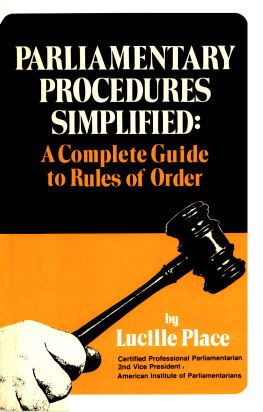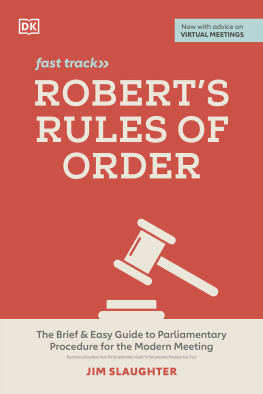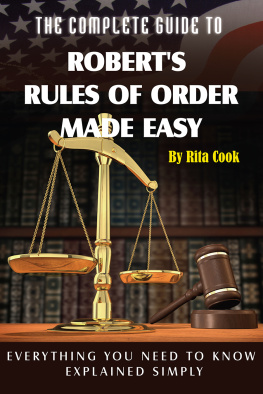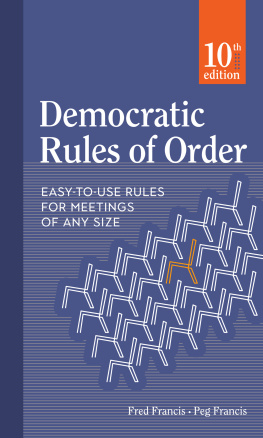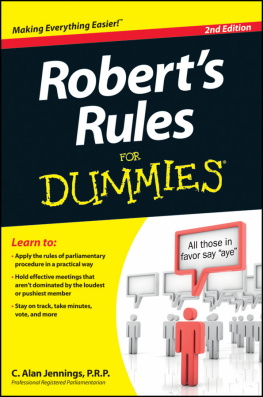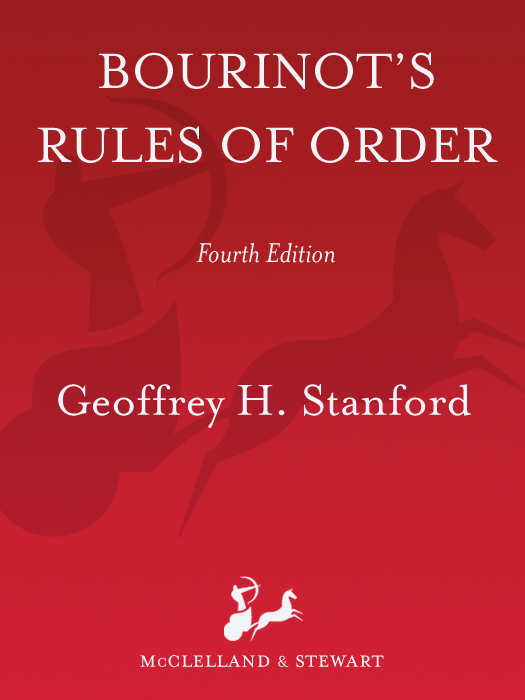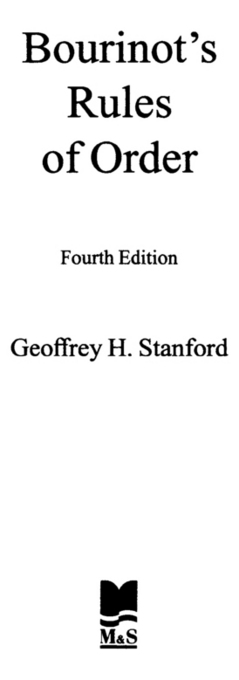Copyright McClelland & Stewart Ltd., 1995
All rights reserved. The use of any part of this publication reproduced, transmitted in any form or by any means, electronic, mechanical, photocopying, recording, or otherwise, or stored in a retrieval system, without the prior written consent of the publisher or, in case of photocopying or other reprographic copying, a licence from the Canadian Copyright Licensing Agency is an infringement of the copyright law.
Library and Archives Canada Cataloguing in Publication
Stanford, G. H. (Geoffrey Hunt), 1906
Bourinots Rules of order
4th ed.
eISBN: 978-1-55199-527-4
1. Canada. Parliament. House of Commons Rules and practice. 2. Public meetings. I. Bourinot, John George, Sir, 1837-1902. Bourinots rules of order. II. Title. III. Title: Rules of order.
JL148.B72 1995 328.7105 C95-930695-1
We acknowledge the financial support of the Government of Canada through the Book Publishing Industry Development Program and that of the Government of Ontario through the Ontario Media Development Corporations Ontario Book Initiative. We further acknowledge the support of the Canada Council for the Arts and the Ontario Arts Council for our publishing program.
McClelland & Stewart Ltd.
75 Sherbourne Street
Toronto, Ontario
M5A 2P9
www.mcclelland.com
v3.1
Contents
Introduction
People attending a formal meeting for the first time are often mystified even intimidated by the rules of order used. With their motions and seconders and calls for the previous question the rules seem devised to complicate decision making. But anyone who has ever attended a large meeting that tried to make its decisions through consensus, without rules of procedure, will appreciate that a few rules would have made the process less protracted and repetitive.
Parliamentary rules of order, in one version or another, are used around the world for meetings of all kinds because they are fair and democratic, allowing for decisions to be made on the basis of the will of the majority, while respecting the opinions of the minority and permitting all participants to express their views without fear of censure. Bourinots Rules of Order is based on the parliamentary rules of the House of Commons in Ottawa.
The origins of these rules date back to the signing of the Magna Carta in Britain in 1215, which was the first attempt to place constitutional limits on the power of the monarchy. The rules developed over the centuries, reflecting parliaments growing independence and its increasing commitment to democratic practice. The British Empire brought parliamentary rules to all parts of the globe, and even colonies that rebelled against Britain, such as the American colonies, continued to use these rules, modifying the details for their own legislative purposes. Parliamentary rules were used in Canada long before Confederation, but the Constitution Act of 1867 confirmed them as the rules of order for the Canadian Parliament.
The underlying objective of parliamentary procedure is to establish and maintain conditions in the House of Commons that permit a free and fair exchange of views on issues brought to the members for a decision. As members of Parliament represent different parties and local interests, and often come from different cultural backgrounds, the rules have to be precise and fair and must be even-handedly applied by a Speaker or other presiding officer whose impartiality and understanding of their purpose is beyond question.
Jeremy Bentham (1748 1832), an English political theorist, set out in his Essay on Political Tactics what he considered to be the four fundamental rules or principles for legislative procedures. The ideas of Bentham and his followers were influential in the reform of the British parliament in the nineteenth century.
Publicity, says Bentham, is the most important of these principles. All proceedings of a parliament should be open to public scrutiny, and the members of the parliament, the press, and through them the public, should receive adequate notice of the hours of sitting and of the business that will be considered at any sitting. Only by means of such publicity could the populace give its support and assent to the formulation of new laws.
Benthams second principle concerns the absolute impartiality of the Speaker or presiding officer. He recommends that there is only one presiding officer, but that a substitute should be available at all times. He goes on to say that the Speaker performs the two functions of being a judge between individual members, and of being an agent of the whole assembly. To preserve impartiality, the Speaker should be excluded from usual parliamentary activity and lose his (or her) rights as a member to propose motions, to participate in debate, or to vote. The Speaker cannot be a judge unless he (or she) is above all suspicion of partisanship, and the Speakers actions, in turn, must be subject to the final authority of the assembly.
The third principle concerns the forms of parliamentary procedure. Bentham suggests that proposition, debate, and voting be conducted in separate stages. This provides for orderly progress and avoids a confusion of issues.
Benthams final principle has to do with freedom of speech. He contends that members should be allowed to speak as often as they wish, to prevent the minority from being overwhelmed. Most modern legislatures find themselves unable to comply with this dictum; their rules of procedure as set out in Standing Orders usually ensure a fair allocation of time for the expression of opinion, but place certain limits on how that time is used, or on how long each member can speak, so that decisions can be made and the subordination of parliamentary rights to an individual or minority is avoided.
Parliament, the model for all assemblies, should be, in the words of Winston Churchill, a strong, easy, flexible instrument of free debate. It achieves this by observing sensible rules that allow the orderly consideration of the questions before it, leading to a decision that expresses the Houses collective will or opinion. Unanimity cannot always be reached, but procedures that ensure proper deliberation of an issue will lead to acceptance and wider support of the outcome and will also help to avoid misunderstandings and friction in the process. In effect, good procedure is fair play and common sense built on a solid foundation of acknowledged principle. Above all, the rules must not change in the middle of the game.
Bourinots Rules of Order was originally written by Sir John George Bourinot, Chief Clerk of the House of Commons from 1880 until his death in 1902, so that Canadians might better understand the procedures of the House of Commons. The second edition, published in 1962, incorporated the many revisions to the Standing Orders of House of Commons that had modified the original rules and introduced adaptations of the rules for use by other assemblies, including shareholders meetings. The third edition, published in 1977, again brought the rules up to date and simplified both the concepts and the language used to describe them. It also expanded the information given on the use of these rules by non-parliamentary assemblies.
This fourth edition continues this custom. It incorporates the substantive revisions made to the Standing Orders of the House of Commons and to the federal legislation governing corporations, the Canada Business Corporations Act, since the last edition of



